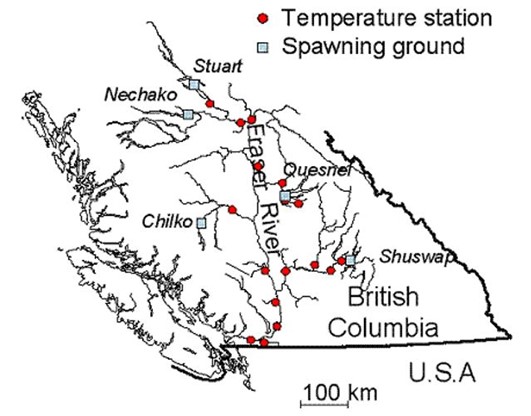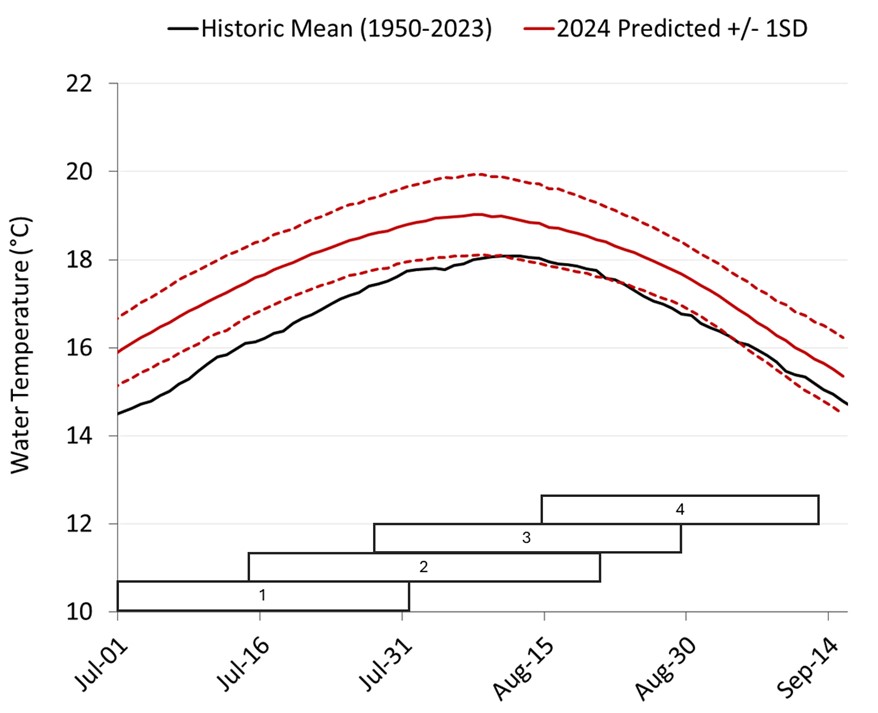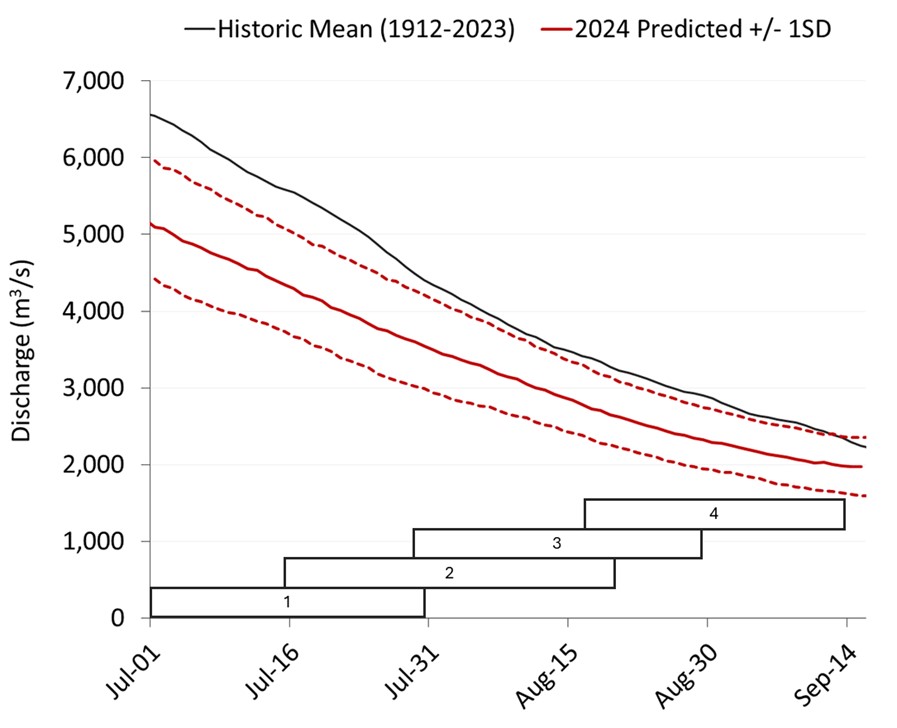Fraser River environmental watch
The DFO Environmental Watch (EWatch) Program provides scientific advice on the impact of different environmental factors on the migration success of Pacific salmon in fresh water. This advice is based on our understanding of migration biology of Pacific salmon and the interaction with environmental conditions.
Environmental watch reports for summer 2024
- 2024-10-17
- 2024-10-15
- 2024-10-10
- 2024-10-07
- 2024-10-03
- 2024-10-01
- 2024-09-26
- 2024-09-24
- 2024-09-19
- 2024-09-16
- 2024-09-12
- 2024-09-09
- 2024-09-05
- 2024-09-03
- 2024-08-29
- 2024-08-26
- 2024-08-22
- 2024-08-19
- 2024-08-15
- 2024-08-12
- 2024-08-08
- 2024-08-05
- 2024-08-01
- 2024-07-29
- 2024-07-25
- 2024-07-22
- 2024-07-18
- 2024-07-15
- 2024-07-11
- 2024-07-08
- 2024-07-04
- 2024-07-02
Archived Fraser River environmental watch reports
Program information
We address our research objectives using a three-fold approach:
- Monitoring, analysis, and forecasting of Fraser River environmental conditions
- Field and laboratory research on migration biology of Pacific salmon
- Quantitative modeling of salmon migration behaviour and success
We combine information from our environmental and biological monitoring programs to develop quantitative models that can be used to evaluate and forecast the influence of freshwater conditions on salmon migratory success. The environmental monitoring program consists of a comprehensive network of temperature logger stations along key salmon migration routes in operation since the 1990's. The biological research component of our program seeks to better understand the relationships between freshwater migration conditions and salmon reproductive development, stress response, disease, energy utilisation, migration behaviour, thermal ecology, and homeostasis. Ultimately, the research conducted through the EWatch program is used to provide scientific advice to both fisheries and habitat managers based on a combination of environmental forecasts, ecological modeling, and salmon migration research. A specific example is the provision of pre-season and in-season scientific advice to fisheries managers to assist in the prediction of en route loss (salmon that die in fresh water during their migration to the spawning grounds) and pre-spawning mortality (salmon that survive to the spawning grounds but die before they successfully deposit all of their eggs) associated with adverse river conditions.

Locations of key EWatch and WSC temperature monitoring stations and major Fraser River sockeye salmon spawning grounds
Long text version
Temperature station: 7 along the Fraser River North of Chilko. 9 along the Fraser River by Shuswap and South of Shuswap.
Spawning ground: Stuart, Nechako, Chilko, Quesnel, Shuswap
The majority of work conducted by EWatch is enhanced by facilitating additional research on Pacific salmon and environmental monitoring through productive collaborations with other research groups within DFO and external government and academic institutions, including University of British Columbia, Simon Fraser University, Carleton University, Pacific Salmon Commission, University of Northern British Columbia, BC Ministry of Environment, and Dalhousie University (EWatch collaborators).
Current research projects and interests include: salmon carcass behaviour, reproductive physiology of adult migrants, thermal tolerance and disease progression, inter-annual variation in energy status of returning sockeye, causes of pre-spawning mortality, post-release stress from fishing, sockeye thermal ecology, climate impacts on migration conditions, smolt condition during freshwater migration, fry out-migration behaviour, juvenile swim performance, and intergenerational consequences of harsh migration conditions on egg-fry survival and offspring fitness (EWatch publications).
In early June, the EWatch program generates long-range forecasts of lower Fraser River summer temperature and flow conditions using relationships between winter snowpack accumulation, summer air temperatures and river environmental conditions (Patterson and Hague 2007). Long-range forecasts can be used to guide pre-season fishery planning given the expected environmental conditions in the river and their potential impact on returning adult salmon. Average 31-day temperature and flow conditions for the current year from forecasted summer air temperature anomalies for BC (provided by Environment and Climate Change Canada - ECCC) and the forecasted contribution of snowmelt to summer flows (provided by the BC River Forecast Centre). Fraser River discharge data are provided by Water Survey of Canada (WSC / ECCC) calculated from water height data collected on a real-time basis from a site in the lower river. Fraser River water temperatures are provided by real-time data loggers placed at sites throughout the Fraser Basin operated by EWatch and Water Survey of Canada. These forecasts are updated in bi-weekly online reports from July to September to provide information to fisheries managers on the status of freshwater migration conditions for incoming sockeye salmon runs.
Long-range forecasts of lower river temperature and flow issued June 1, 2023, predicts below average flows and above average temperatures for the lower Fraser River at Hope during the summer of 2022. In addition, long-range forecasts for Fraser River above Texas Creek (in consideration of Big Bar), predict below average flows, and above average (July to Aug) to average water temperatures (September).
31-day average lower Fraser River pre-season temperature forecast centered on each date

The bars indicate the approximate date range over which different sockeye salmon management groups pass the lower river temperature stations (1 = Early Stuart; 2 = Early Summer; 3 = Summer; 4 = Lates).
Long text version
Graph showing temperatures in °C for the historic mean from 1950 to 2023, and the 2024 predicted values.
Trends show the historic mean starts at approximately 14.5 °C in the beginning of July, rising to its peak at 18.1 °C around August 12. It then declines to approximately 14.8 °C mid-September. The predicted 2024 temperature starts at approximately 16.0 °C in the beginning of July, rising to its peak at approximately 19.0 °C around August 4. It then declines to approximately 15.4 °C in mid-September. The 2024 water temperature forecast is above the historic mean for the entire season.
Approximate date range over which different sockeye salmon management groups pass the lower river temperature stations:
- July 1 to July 31 – Early Stuart
- July 16 to August 20 – Early summer
- July 31 to August 30 – Summer
- August 18 to September 14 – Lates
31-day average lower Fraser River pre-season discharge forecast centered on each date

The bars indicate the average date range over which different sockeye salmon management groups pass the lower river discharge stations (1 = Early Stuart; 2 = Early Summer; 3 = Summer; 4 = Lates).
Long text version
Graph showing discharge in m3/s for the historic mean from 1912 to 2023, and the 2024 predicted values.
Trends show the historic mean starting at 6 500 m3/s in the beginning of July and declining gradually to a low of approximately 2 300 m3/s in mid-September. The 2024 predicted discharge starts around 5 200 m3/s in the beginning of July and declines gradually to approximately 2 000 m3/s in mid-September. The 2024 discharge forecast is well below historic means for the season.
Average date range over which different sockeye salmon management groups pass the lower river discharge stations:
- July 1 to July 31 – Early Stuart
- July 16 to August 20 – Early summer
- July 31 to August 30 – Summer
- August 18 to September 14 – Lates
Related links
- Program staff and publications
- Fraser River fisheries data
- Pacific Salmon Commission
- BC weather map
- BC River Forecast Centre
- Date modified: